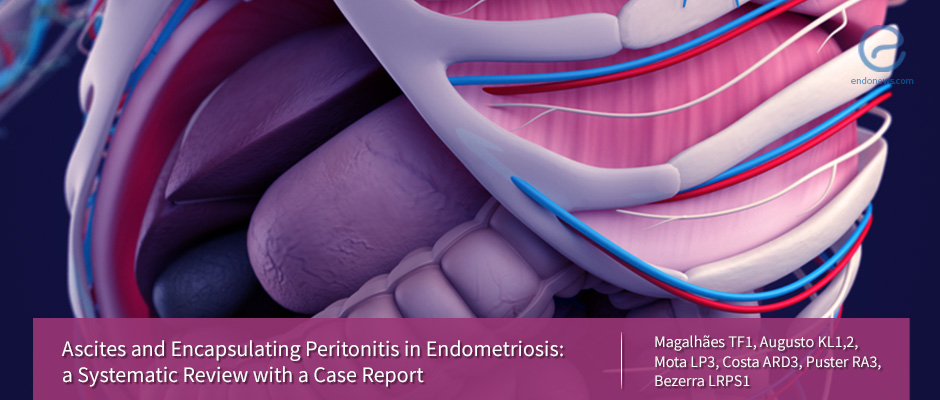Difficulties Associated with Diagnosing Ascites and Encapsulating Peritonitis in Endometriosis
Jun 8, 2018
Endometriosis can present itself in different ways, including with overt ascites and peritonitis, so health care providers should be able to diagnose these rare forms of the disease and be given the tools to address these types of endometriosis.
Key Points
Highlights:
- This publication is a systematic review and a case report that presents unique presentations of endometriosis, including overt ascites and peritonitis.
Importance:
- Raising awareness of the myriad of presentations of endometriosis will lead to greater diagnostic accuracy for some specific and rare types of endometriosis.
What’s done here?
- The researchers scoured the PubMed Database for literature that spoke about women with endometriosis who had clinically significant ascites, frozen abdomen, or encapsulating peritonitis. Relevant data were extracted from the different publications.
- The second part of this publication is a case report detailing a case of a woman who was seen by the authors at their clinic. This woman had endometriosis, recurrent ascites, and encapsulating peritonitis.
- The woman’s symptoms were: Wasting Syndrome / Increased abdominal girth / Shortness of breath / Darkened stools / Loss of appetite / Progressive pain in abdomen and thoracic areas during menses / Cyclic dyspareunia
- Cancer antigen 125 were high
- Further examination led to the
- discovery of the loculated cystic ascites produced a mass effect by ultrasound and contrasted computed tomography.
- Thick hemorrhagic fluid discovered by a paracentesis, that is highly cellular with low albumin; without bacterial growth or cancer cells.
- A diagnostic laparoscopy revealed adhesions, peritoneal lesions, and a “frozen” abdomen because of encapsulating peritonitis.
- The peritoneal biopsy pointed towards chronic peritonitis and few hemosiderin deposits.
- Once the patient was referred to a gynecology center, a gynecological exam, ultrasound mapping, and an MRI were used to confirm the diagnosis of endometriosis
- The patient also had fibrosis in the anterior vaginal fornix / Many peritoneal endometriosis nodules / Bilateral hemorrhagic ovarian cysts as well.
- The patient was prescribed goserelin acetate. After 6 months, the researchers found that the patient was asymptomatic.
Key results:
- The systematic review led the authors to 37 articles. These articles described the plight of 42 women.
- All the patients had the similar type of ascitis: Hemorrhagic and recurrent; not predictable by CA-125.
- Infertility, dysmenorrhea, and dyspareunia were not consistently reported in the reviews.
- The different pieces of literature prescribed different treatments across the various publications. Suffice to say, the treatment outcomes were also different.
- The authors state that the disease in question, endometriosis, is heterogeneous in nature and should be approached as thus during diagnosis. There ought to be a differential diagnosis looking at the massive hemorrhagic ascites.
Limitations of the study:
- The authors state that one of the limitations of the study is the fact that the literature search only included articles written in 4 different languages. Additionally, the authors did not include articles of a certain age because they were not available online.
Lay Summary
De Magalhães et al. recently published a paper titled “Ascites and Encapsulating Peritonitis in Endometriosis: a Systematic Review with a Case Report” in Revista Brasileira de Ginecologia e Obstetrícia. The team from the Universidade Federal do Ceará and the Universidade de Fortaleza wanted to increase awareness of a unique presentation of endometriosis, namely overt ascites and peritonitis. Over the course of the article, the authors discuss their systematic review and delineate a case seen at the author’s institution.
For the review, the authors scoured PubMed for publications that discuss women with clinically significant ascites, frozen abdomen, or encapsulating peritonitis. Any relevant literature was then mined for data. The authors were able to find 37 articles, which in total discussed the plight of 42 patients. The ascites were mostly found to be recurrent and hemorrhagic. They also could not be sought out using cancer antigen 125 (CA-125) levels. The literature review did not yield consistent reports of infertility, dyspareunia, and dysmenorrhea. Different papers chose different treatment options and that led to different outcomes in the studies.
The case report discussed the experience of a 28-year-old woman who had endometriosis, encapsulating peritonitis, and recurrent ascites. The patient presented with many different symptoms including but not limited to wasting syndrome decreased appetite, dark stools, and menses-associated progressive abdominal and thoracic pain. The patient underwent an abdominal ultrasound, contrasted computed tomography (CT), diagnostic laparoscopy, and paracentesis procedure. The healthcare provider was able to discern ascites and hemorrhagic fluid. There was no bacterial growth or cancerous cells present in the fluid. The patient’s abdomen was said to have encapsulating peritonitis and was described as “frozen.” A peritoneal biopsy was conducted. Another contrasted abdominal CT was taken on a different day and the patient was then referred to a gynecology clinic. The patient underwent a gynecological exam, ultrasound mapping, magnetic resonance imaging (MRI) scan, chest CT, colonoscopy, and laparoscopy. More abnormal structures were seen including anterior vaginal fornix fibrosis and peritoneal nodules. The healthcare provider prescribed goserelin acetate and the patient was asymptomatic after 6-months.
Overall, the authors emphasize the heterogeneous nature and presentation of the disease. They call for a differential diagnosis of the condition. It is important to note that there are no specific protocols that delineate diagnosis and the treatment of the condition described in detail in the publication.
Research Source: https://www.ncbi.nlm.nih.gov/pubmed/29554705
Overt Ascites Encapsulating Peritonitis CA-125 frozen abdomen infertility dyspareunia dysmenorrhea CT MRI laparoscopy ultrasound biopsy goserelin acetate

